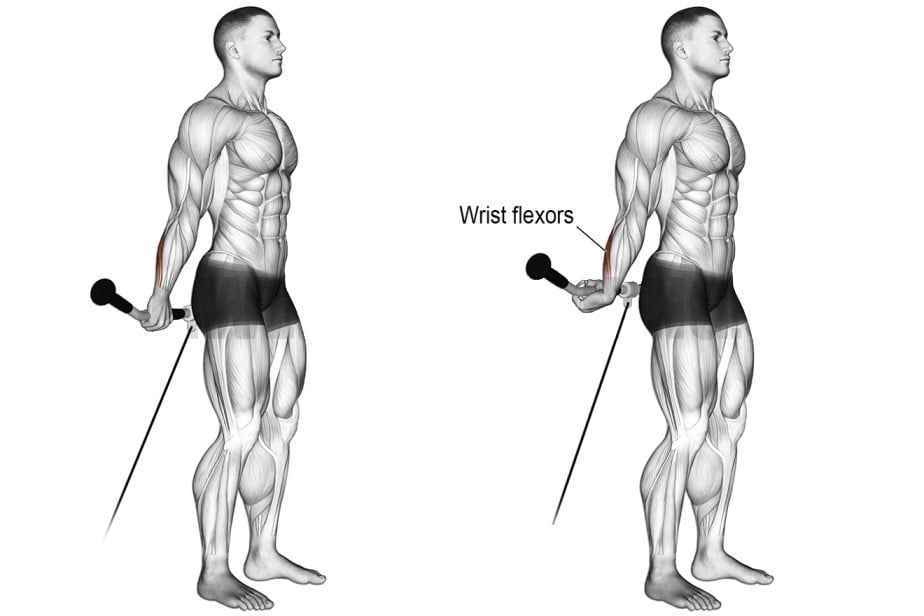A cable wrist curl is an exercise that primarily targets the forearm (flexor muscles), fingers, and wrists.
But don’t underestimate its simplicity.
Cable wrist curls are a simple yet effective way to build bigger and stronger forearms, improve grip and wrist strength, and enhance weight-lifting capability.
I’ve found it to be a good forearm exercise as it provides continuous tension throughout the range of motion.
Personally, I include cable wrist curls in my workouts to strengthen my forearm and grip, which helps me lift heavy weights during deadlifts and bench presses.
According to the study, a 12-week periodized forearm training program can enhance wrist and forearm strength and bat-end velocity in baseball players.

How To Do Seated Cable Wrist Curl
- Attach a straight or EZ curl bar to the cable machine’s low pulley.
- Sit on a bench or chair with a straight back, legs shoulder-width apart, and feet flat on the ground.
- Rest the back of your lower arms on your quad or the chair’s armrests, and allow your wrists to hang over the edge/knee.
- Grasp the bar with an underhand grip (palms facing up) with your hands around shoulder-width apart.
- Slowly curl your wrists upwards and bring the bar toward your forearm by flexing your wrists. Go up as far as comfortably possible without compromising form.
- Keep the contraction for a second, then slowly lower your wrists back down to the starting position while inhaling.
- Do 8-12 reps for 2-3 sets.
Tips and Form
- Keep your elbows glued to your thighs throughout the exercise. Don’t use any swinging or jerking motions to lift the weight.
- Ensure that you are not using your biceps or shoulders to help lift the barbell.
- Avoid gripping too wide or too narrow, as it can compromise proper wrist alignment.
- Do not hyperextend your wrists at the bottom of the movement. Lower the bar until you feel comfortable stretching it, but don’t go beyond what your body can do naturally.
- To increase the difficulty of the exercise, use a thick bar or add fat grips to your bar. This variation challenges your grip strength and activates more forearm muscle fibers.
- You are free to adjust the weight on the cable machine to target different goals. Use lighter weights for higher reps (12-15+) to build muscle endurance, and heavier weights for lower reps (8-12) to build muscle mass and strength.
Behind-The-Back Cable Wrist Curl
The behind-the-back cable wrist curl is a variation of the standard wrist curl that offers some unique benefits and challenges.
- The behind-the-back position allows for a greater stretch of the wrist flexors at the bottom of the movement. This extended range of motion can lead to better muscle activation and flexibility.
- This position is less comfortable for some people than the standard pronated grip. Maintaining proper form can also be difficult with the behind-the-back variation.
If you are a beginner, first start with the standard cable wrist curl and then move to the back option.
How To Do

- Attach a straight or EZ curl bar to the low pulley cable machine.
- Pick up the bar and stand close to it, but facing away from the pulley.
- Reach behind your back and grasp the bar with a shoulder-width pronated grip (palms facing up).
- Ensure a firm grip on the bar to maximize muscle engagement and prevent the bar from slipping.
- Keep your elbows pinned to your sides and your torso stable. Contract your forearms to curl your wrists upwards.
- Hold for a count of two.
- Reverse the motion and return the bar to its original position, with the bar resting on your fingers.

Manish is a NASM-certified fitness and nutrition coach with over 10 years of experience in weight lifting and fat loss fitness coaching. He specializes in gym-based training and has a lot of knowledge about exercise, lifting technique, biomechanics, and more.
Through “Fit Life Regime,” he generously shares the insights he’s gained over a decade in the field. His goal is to equip others with the knowledge to start their own fitness journey.
